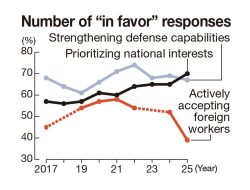Unbalanced information diet: AI-generated deception / OSINT Reveals Discrepancies in Gaza Hospital Explosion Images; Technology Developed to Recognize AI-Generated Material

Eliot Higgins speaks during an online interview with The Yomiuri Shimbun on Nov .1.
The Yomiuri Shimbun
18:30 JST, January 28, 2024
This is the final installment in a series examining moves to spread biased information through the use of generative artificial intelligence, acts that threaten our democracy.
***
Eliot Higgins, founder of the private research organization Bellingcat, has popularized the method of “Open Source Intelligence” (OSINT) worldwide, which investigates and analyzes public information to find the truth.
The Middle Eastern satellite television network Al Jazeera reported in a breaking news story on Oct. 17 that 500 people had been killed in an explosion at Al-Ahli Hospital in Gaza.
The Islamist group Hamas claimed the hospital was attacked in an Israeli strike. Israel countered that the hospital was hit by a missile launched by a Hamas-affiliated group in Gaza. It was debatable which side actually launched the attack.
Bellingcat quickly analyzed numerous videos and images of the aftermath posted on social media.
The following day, Bellingcat published a report on the investigation under the title: “Identifying Possible Crater from Gaza Hospital Blast.”
Bellingcat indicated that the hospital blast was not caused by the Israeli military, stating in a report that the size of the crater was too small to be caused by typical Israeli munitions.
Human Rights Watch, an international human rights organization, also conducted its own investigation and indicated that the explosion may have been a misfire by a Palestinian armed group.
Higgins said “Because this is the worst situation in which a large amount of disinformation is circulating, Bellingcat immediately disproved it and told only the facts for what the evidence can tell.”
Concerns over AI evolution
There are researchers in Japan who analyze satellite and social media images, such as Yu Koizumi, associate professor at the University of Tokyo’s Research Center for Advanced Science and Technology, who is an expert on Russian affairs.
He showed us a single satellite image, taken of a Russian military base on the northern territories’ Etorofu Island. Before the Russian aggression into Ukraine began in February 2022, the base was equipped with S-300 surface-to-air missiles. However, they have not been seen since autumn that year.
Antiaircraft missiles that were deployed in other regions in the Far East have also disappeared one after another. Koizumi believes that these missiles were probably redeployed to the Ukrainian front.
In February last year, the Russian military announced that it had conducted S-300 launch drills in the vicinity of the island of Etorofu.

University of Tokyo Associate Professor Yu Koizumi speaks at the Research Center for Advanced Science and Technology in Tokyo on Nov. 27.
“Russia might have released false information in order to show that it is maintaining its strength in the Far East as well,” Koizumi said.
Koizumi also expressed concerns about the evolution of generative AI. “If a large number of false images are circulated, OSINT’s methods could collapse,” he said.
Originator Profile
Originator Profile (OP) is a digital technology that makes it possible to reliably identify articles. A key feature of the technology is that clicking on an online article brings up a frame displaying the newspaper’s name and its reporting guidelines.
The sender’s information embedded in the article does not disappear even if it is copied to asocial media.
Shigeya Suzuki, a specially-appointed professor at Keio University who leads the development division of the OP Collaborative Innovation Partnership said that the goal of the first stage of the verification experiment that began in July has been completed.
OP is also said to be effective in countering disinformation generated by AI.
Through the use of OP technology, AI-generated information will be tagged so that recipients can recognize the information as being “AI-generated”.

Shigeya Suzuki, a specially-appointed professor at Keio University, left, explains about an experiment of the Originator Profile in Minato Ward, Tokyo, on Nov. 24.
There are concerns that the quality of AI-generated information will deteriorate rapidly as AI relearns information that already contains AI-generated errors.
However, this tag would prevent such relearning, they said.
The partnership aims to standardize OP internationally. “OP is highly flexible and has a wider range of applications than expected,” Suzuki said.
The Content Authenticity Initiative (CAI), which has more than 2,000 member companies worldwide, including news organizations, is also promoting similar initiatives in the area of images.
The CAI intends to embed information into the image, such as who took the photo and how it was processed, so that it can be verified even if it has been processed by AI.
“Creating a system that allows people to check the ‘history’ of information on the internet is important for society as a whole,” said Shoichi Nishiyama, chief digital officer at the Japan arm of U.S. software giant Adobe Inc., which operates the CAI office.
There is no special medicine to protect society from information that manipulates the public will. It is necessary to implement all kinds of countermeasures, including OSINT, OPs and information literacy.
Popular Articles
Popular articles in the past 24 hours
-

Govt Aims to Expand NISA Program Lineup, Abolish Age Restriction
-

Teen in Japan Arrested Over Cyberattack on Internet Cafe Operator...
-

Tokyo Metropolitan Government to Hold Its First International Art...
-

Japan Govt to Soon Submit Lower House Seat Reduction Bill That Co...
-

Kamakura City to Suspend ‘Slam Dunk’ Manga License Plates as Meas...
-

University Hospitals: Work to Maintain Functions through Stable M...
-

Abe Shooting Defendant Yamagami Apologizes to Slain PM's Family f...
-

Japan's Civil Aviation College Students Grounded by Lack of Fligh...
Popular articles in the past week
-

8 Japanese Nationals Stranded on Indonesia's Sumatra Island
-

Violations of Subcontract Law: Major Automakers Must Eliminate Ol...
-

Trains with Large Spaces for Baby Strollers, Wheelchairs on the R...
-

Local Governments’ Tax Revenues: Devise Ways to Correct Imbalance...
-

Big Leap in Quest to Get to Bottom of Climate Ice Mystery
-

Van Cleef & Arpels Dazzles with Art Deco Artisanry at Tokyo Exhib...
-

Yoshinobu Yamamoto Cheered by Los Angeles Lakers Fans at NBA Game
-

Survey Finds 59% of Japanese Opposed to Actively Accepting Foreig...
Popular articles in the past month
-

Govt Plans to Urge Municipalities to Help Residents Cope with Ris...
-

Japan Resumes Scallop Exports to China
-

Japan Prime Minister Takaichi Vows to Have Country Exit Deflation...
-

Japan to Charge Foreigners More for Residence Permits, Looking to...
-

Japan GDP Down Annualized 1.8% in July-Sept.
-

JR East Suica's Penguin to Retire at End of FY2026; Baton to be P...
-

Tokyo's Off Limit Areas Becoming Popular for Tours
-

Corporate Interim Earnings: Companies Must Devise Ways to Overcom...
"Society" POPULAR ARTICLE
-

Tokyo’s Off Limit Areas Becoming Popular for Tours
-

Fire Damages 170 Buildings in Oita, Western Japan
-

Tatsuya Nakadai, Japanese Actor, Dies at 92; Appeared in Films Including “The Human Condition” and “Ran” (UPDATE 1)
-

M5.7 Earthquake Hits Japan’s Kumamoto Pref., Measuring Upper 5 Intensity, No Tsunami Expected
-

No Easy Fix for Tokyo’s Soaring Real Estate Prices
JN ACCESS RANKING
-

Govt Plans to Urge Municipalities to Help Residents Cope with Rising Prices
-

Japan Resumes Scallop Exports to China
-

Japan Prime Minister Takaichi Vows to Have Country Exit Deflation, Closely Monitor Economic Indicators
-

Japan to Charge Foreigners More for Residence Permits, Looking to Align with Western Countries
-

Japan GDP Down Annualized 1.8% in July-Sept.








